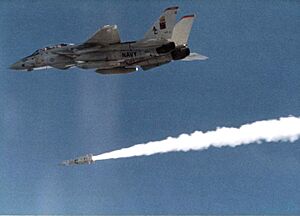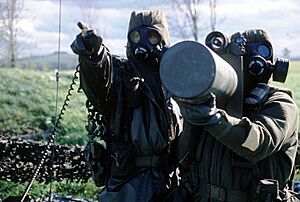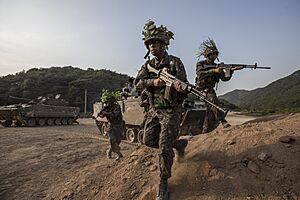Modern warfare facts for kids
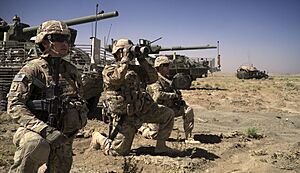
Modern warfare describes how wars are fought today. It also covers how fighting has changed over time. This includes new ideas, methods, and technology. To win, armies must always update their ways of fighting.
This topic is always changing. What is considered "modern" depends on the time and place. Sometimes, it just means how wars are fought right now. Other times, it includes all wars since the invention of gunpowder. Important changes include the use of powerful artillery in the Crimean War. Also, armies started using trains in the American Civil War. New weapons like the machine gun, airplanes, tanks, and radios changed World War I. Modern warfare also includes ideas like total war, industrial warfare, mechanized warfare, nuclear warfare, and asymmetric warfare.
Contents
- History of Modern Warfare
- Types of Modern Warfare
- Aerial Warfare: Fighting in the Sky
- Asymmetric Warfare: Unequal Fights
- Biological Warfare: Germ Warfare
- Chemical Warfare: Using Chemicals to Fight
- Electronic Warfare: Hacking and Jamming
- Fourth Generation Warfare: Blurry Lines
- Ground Warfare: Fighting on Land
- Guerrilla Warfare: Hit and Run Tactics
- Information Warfare: Using Data and Media
- Naval Warfare: Fighting at Sea
- Network-Centric Warfare: Connected Fighting
- New Generation Warfare: Russian Theory
- Nuclear Warfare: Atomic Weapons
- Space Warfare: Fighting Beyond Earth
- Major Modern Wars
History of Modern Warfare
Modern warfare began in the early modern period, around the 1500s. Many wars since then have used new military techniques. Key wars that show these changes include the Thirty Years' War and the Napoleonic Wars. The two World Wars and the War on Terror also shaped modern fighting.
Types of Modern Warfare
Some people believe that new ways of fighting are just updates to older technologies.
Aerial Warfare: Fighting in the Sky
Aerial warfare uses military aircraft and other flying machines. This includes bombers attacking enemy targets. Fighter aircraft battle for control of the sky. Attack aircraft help ground troops. Naval aviation attacks targets at sea and nearby land.
Other aircraft carry airborne forces like paratroopers. Aerial refueling tankers help planes fly longer. Military transport aircraft move supplies and people.
Asymmetric Warfare: Unequal Fights
Asymmetric warfare happens when two sides in a conflict are very different in strength. One side might be a powerful army. The other could be a smaller group. They use different strategies and tactics. These often go against normal ways of fighting.
Biological Warfare: Germ Warfare
Biological warfare, or germ warfare, uses living things as weapons. This could be bacteria, viruses, or other disease-causing organisms. It is meant to make enemy soldiers sick or kill them. It can also harm animals or plants. This type of warfare involves releasing harmful germs on purpose.
Chemical Warfare: Using Chemicals to Fight
Chemical warfare uses toxic chemicals to harm or kill enemies. These chemicals can cause serious illness or death. Governments and emergency teams need to know about these chemicals. They also need to know how to treat people exposed to them.
Electronic Warfare: Hacking and Jamming
Electronic warfare uses non-violent methods to help in war. It first involved listening to and decoding enemy radio communications. It also included ways to stop enemies from listening. This includes jamming signals and making equipment hard to detect.
Today, it covers much more. It includes using and avoiding radar and sonar systems. It also involves computer hacking.
Fourth Generation Warfare: Blurry Lines

Fourth generation warfare (4GW) describes modern conflicts. In these wars, one main side is not a country. Instead, it's often a violent group with strong beliefs. The lines between war and peace become unclear. Fighters and civilians are harder to tell apart. Battlefields can be anywhere.
This type of war is different from terrorism. It's also narrower than asymmetric warfare. In 4GW, the non-state group often tries to set up its own government. The news media also plays a big role in how people see these conflicts.
Ground Warfare: Fighting on Land
Ground warfare uses three main types of fighting units: infantry, armor, and artillery.
Infantry: The Foot Soldiers
Modern infantry includes mechanized infantry (who ride in vehicles) and airborne forces (who parachute in). They usually carry rifles or sub-machine guns. An infantryman is the basic soldier in an army.
Armor: Armored Vehicles
Armored warfare uses many types of armored fighting vehicles. These are for battle and support. Tanks and other armored vehicles are strong and slow. They can resist machine gun fire. But they are weak against rockets, mines, and aircraft. So, infantry usually goes with them.
In cities, armored vehicles can be exposed to hidden enemies. But they can still be very important in urban combat. In the countryside, mud and wet ground can make it hard for tanks to move.
Artillery: Big Guns
Artillery today means large guns that fire explosive shells or rockets. They are so big they need special mounts to fire and move. This includes howitzers, cannons, mortars, and field guns. It also includes rocket artillery. Modern artillery can use smart guidance systems to hit targets very precisely.
Guerrilla Warfare: Hit and Run Tactics
Guerrilla warfare is fighting by small groups of irregular troops. They operate in areas controlled by the enemy. Guerrillas use deception and ambushes. They avoid large, direct battles. They do best in rough terrain and with support from local people.
Guerrilla fighters often use weapons that are easy to get and cheap. These include the AK-47, RPGs, and Improvised explosive devices. Their main weakness is not having advanced equipment. They rely on small attacks and then retreating. This often leads to low intensity warfare and asymmetrical warfare.
Information Warfare: Using Data and Media
Information warfare uses information and attacks on information systems as a tool of war. This became possible with the spread of electronic media. Examples include disrupting money transfers or jamming TV and radio signals. This allows one side to spread false information.
Propaganda: Influencing Opinions
Propaganda sends messages to influence many people's opinions. Instead of just giving facts, propaganda presents information to guide how people think. The best propaganda can be true, but it often picks facts carefully. It might also use emotional messages. The goal is to change how people understand things.
Psychological Warfare: Spreading Fear
Psychological warfare aims to influence the thoughts and feelings of enemy groups. This is done to help achieve national goals. An early example is Genghis Khan letting some civilians flee. This spread fear to nearby areas.

Naval warfare happens on the open ocean. Usually, only large, powerful countries have strong navies that can operate far from shore. Modern navies use aircraft carriers, submarines, frigates, cruisers, and destroyers. These ships can attack targets on land, in the air, or other ships.
Most modern navies also have many aircraft. These planes fly from aircraft carriers. In the Vietnam War, fighting also happened in rivers and coastal areas. This is called riverine warfare.
Network-Centric Warfare: Connected Fighting
Network-centric warfare is a new military idea. It uses the Information Age to connect everything. Weapons, sensors, and control centers are linked by fast communication networks. This helps different parts of the military work together better.
New Generation Warfare: Russian Theory
New generation warfare is a Russian military idea. It focuses on the psychological side of war. It also looks at how people are affected. It tries to use non-military influence first. This makes armed conflict less costly if it happens.
Nuclear Warfare: Atomic Weapons
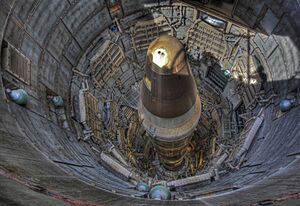
Nuclear warfare uses nuclear weapons. There are two main types. A limited nuclear war uses a small number of weapons. These are aimed at enemy soldiers. A full-scale nuclear war uses many weapons. These are aimed at entire countries, including civilians.
Space Warfare: Fighting Beyond Earth
Space warfare is fighting that happens outside Earth's atmosphere. So far, no wars have been fought in space. Weapons could include those in orbit or space weapons. Important targets in space would be satellites and weapon platforms. Right now, this is mostly science fiction.
Major Modern Wars
- 1803 – Napoleonic Wars
- 1839 – Opium Wars
- 1846 – Mexican–American War
- 1853 – Crimean War
- 1861 – American Civil War
- 1864 – Paraguayan War
- 1870 – Franco-Prussian War
- 1877 – Russo-Turkish War
- 1879 – Anglo-Zulu War
- 1879 – War of the Pacific
- 1881 – Mahdist War
- 1899 – Second Boer War
- 1904 – Russo-Japanese War
- 1911 - Italo-Turkish War
- 1912 – Balkan Wars
- 1914 – World War I
- 1917 – Russian Civil War
- 1918 – Interwar Period
- 1919 – Turkish War of Independence
- 1932 – Colombia–Peru War
- 1935 – Second Italo-Ethiopian War
- 1936 – Spanish Civil War
- 1937 – Second Sino-Japanese War
- 1939 – World War II
- 1945 - Chinese Civil War (second phase)
- 1946 – First Indochina War
- 1947 – Cold War
- 1950 – Korean War
- 1955 – Vietnam War
- 1961 – Bay of Pigs Invasion
- 1967 – Six-Day War
- 1968 – The Troubles
- 1971 – Indo-Pakistani War of 1971
- 1972 – Nicaraguan Revolution
- 1973 – Yom Kippur War
- 1975 – Angolan Civil War
- 1977 – Ogaden War
- 1979 – Sino-Vietnamese War
- 1979 – Soviet–Afghan War
- 1980 – Iran–Iraq War
- 1982 – Falklands War
- 1983 – Sri Lankan Civil War
- 1988 – First Nagorno-Karabakh War
- 1989 – United States invasion of Panama
- 1990 – Gulf War
- 1991 – Somali Civil War
- 1992 – Bosnian War
- 1998 – Second Congo War
- 2001 – War on Terror
- 2001 – War in Afghanistan
- 2003 – Invasion of Iraq leading to the Iraq War
- 2006 – Mexican Drug War
- 2011 – First Libyan Civil War
- 2011 – Syrian Civil War
- 2012 – Mali War
- 2014 – Iraqi Civil War
- 2014 – Russo-Ukrainian War
- 2014 – Yemeni Civil War
- 2020 – Second Nagorno-Karabakh War
- 2020 – Tigray War
- 2022 – 2022 Russian invasion of Ukraine
- 2023 – Israel-Hamas war


